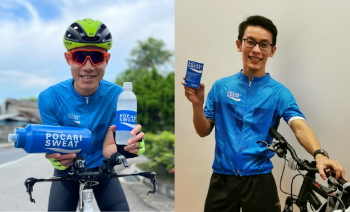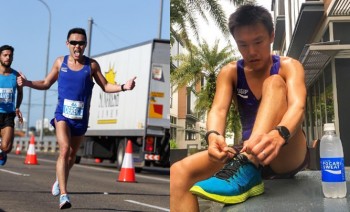
#SafeRiding – Cycling Injuries & Hydration in Sport
Updated: 23 Jun 2022 | Written By: By Drs. Joshua Li, Shauna Sim and Victor Tan (Sports Medicine Association Singapore)
#SafeRiding – Cycling Injuries & Hydration in Sport
By Drs. Joshua Li, Shauna Sim and Victor Tan
Sports Medicine Association Singapore
It is no secret that to be fit and healthy, we need to be physically active. Regular physical activity and exercise can help protect us from diseases such as diabetes, high blood pressure, obesity, heart disease, stroke, and even some cancers. People who exercise regularly also have better mental health and emotional wellbeing.
As a form of aerobic exercise, cycling is a good way to reduce the risk of health problems associated with a sedentary lifestyle. A safe and low-impact activity, cycling can be enjoyed by people of all ages, from young children to older adults. Not to mention, by reducing our carbon footprint, cycling can also be good for the environment!
A Scandinavian study found that cycling increased cardiorespiratory fitness in youths and reduced all-cause and cancer mortality among the middle-aged to elderly. Cycling for at least 30 minutes three times a week has also been shown to improve reaction times and cognitive function amongst older adults. For people suffering from knee pain and have difficulty performing weight-bearing exercise such as jogging, cycling can be a great alternative with reduced joint loading.
Risks Involved with Cycling
While there are many benefits of cycling, it is certainly not without risk. Injuries sustained during cycling can be broadly classified into two categories. First, acute traumatic injuries, such as those incurred during road traffic accidents. And second, overuse injuries, which are mostly due to training and equipment-related problems.
Traumatic Injuries
Considering injuries from all recreational activities, injuries sustained from cycling are one of the top causes for admission to the Accident and Emergency (A&E) department. In January 2022, The Straits Times reported that there was a yearly average of around 560 serious accidents involving cyclists on roads that resulted in injuries or deaths in the last five years in Singapore.
Cycling injuries are mostly the result of falls from bicycles and collisions with moving or stationary objects. Severe and fatal injuries are mainly due to crashes with motor vehicles. Most frequently, cyclists sustain traumatic injuries to the upper and lower extremities, head and face. While minor injuries, including abrasions, contusions, sprains and strains are common, they usually heal well with rest and proper rehabilitation.
Regarding more serious injuries in the upper limb, falls on an outstretched hand can result in fractures of the clavicle (collar bone), scaphoid (wrist) and radius (forearm), just to name a few. Acromioclavicular joint (shoulder) separation injuries are also common, usually caused by direct impact to the shoulder.
Severe traumatic head injuries account for most cycling-related deaths. Fortunately, these are generally preventable with helmets. Mandatory legislation has increased helmet use among cyclists, particularly in younger age groups, and has been shown to reduce bicycle-related deaths in children. In Singapore, the Land Transport Authority’s rules for cyclists state that helmets must be worn when cycling on roads.
Overuse Injuries
The most common site for overuse injuries in cyclists is the knee. Other typical injury sites include the neck, back, hands, foot, hip and perineum (saddle region). Though several conditions are described below, consider consulting a healthcare professional if your injuries do not resolve with rest. Proper diagnosis and management are important for successful recovery.
Pain located in the front of the knee can come from the quadriceps tendon (above the kneecap), patellar tendon (below the kneecap) or patellofemoral joint (behind the kneecap). Pain from behind or either side of the knee can be attributed to hamstring tendon strains, while friction from the iliotibial band is a common cause of outer knee pain.
Fortunately, many of these injuries may be treated by correcting training errors, such as rapid increase in mileage/intensity, improper pedalling technique, high gearing and unaccustomed hill climbing.
An appropriate bike fit is integral to cycling injury prevention of not only the knees, but also the neck and back. Saddle height and position, top tube length and handlebar placement are just but a few of the many variables that should be adjusted according to a cyclist’s specific measurements.
Muscles involved in cycling, including the quadriceps, glutes and hamstrings, should be strengthened as part of rehabilitation after injury. In addition, improving the flexibility and endurance of neck and back muscles can help relieve pain in those regions.
Other Exercise-Related Injuries
Perhaps associated with the increased popularity of spinning classes, exertional rhabdomyolysis, informally known as “rhabdo”, has gained renewed interest in recent years. Almost indistinguishable from the regular muscle soreness in the early phases, rhabdomyolysis is caused by severe muscle damage after strenuous unaccustomed exercise. However, unlike delayed-onset muscle soreness, the onset of severe muscle pain, cramps, weakness and the tell-tale sign of dark “Coca-Cola”-coloured urine, should trigger a prompt visit to the doctor. The mainstay of treatment is aggressive hydration, usually intravenously, and typically requires hospitalisation.
Exertional heat illness is a general term used to describe a range of conditions found in those who do vigorous activity in the heat. Conditions such as heat cramps, heat exhaustion and heat stroke belong to this category. Common risk factors include dehydration, strenuous activity in high temperature and humidity, poor physical fitness, lack of heat acclimatisation, obesity, acute illness and certain medications. While exercising within current fitness levels and avoiding overexertion are important, ensuring adequate hydration is key to preventing exertional heat illness, especially in Singapore’s hot and humid climate.
Importance of Hydration During Sport
Cycling and exercising in warm-hot Singapore can result in water and electrolyte (salt) losses through sweating and respiration. Water constitutes about 60% of the adult human body and serves vital functions, such as body temperature regulation, transportation of nutrients and oxygen, and removal of waste products. Fluid losses exceeding 2% of body weight can have a significant effect on exercise performance, both physically and mentally. Adequate fluid replacement is hence vital to prevent dehydration and minimise the risk of heat injury.
Fluid Replacement for Exercise
Fluid should be taken throughout the day, and one should hydrate well before, during and after exercise. Monitoring urine colour is a quick and easy way to estimate hydration status. (Though beware certain medications and supplements can alter urine colour too!) Urine should be pale yellow if adequately hydrated. If urine is a darker or brighter shade of yellow, this indicates dehydration and fluids should be taken. Hydration before exercise, if required, should be started at least several hours before the session to allow fluid absorption and urine output to return to normal.
The amount of fluid loss with each exercise session can vary based on different environments and training parameters, such as duration and intensity. Hence, hydration during exercise can be highly-variable. Nonetheless, everyone should develop their own customised fluid replacement plan that can prevent excessive (>2% body weight) dehydration. While drinking according to thirst sensation is a practical tip, some guidelines have recommended consuming 400-800ml of fluids per hour of exercise.
Fluid loss can continue even after exercise, so one would need to continue fluid replacement, especially in the initial 4-6 hours. Checking your weight right before and after exercise can estimate fluid loss – 1L of fluid should be replaced for each kilogram of body weight lost after exercise.
What to Drink for Fluid Replacement?
There are many options for fluids replacement. Plain water is suitable as fluid replacement for short-duration (generally <1 hour), low-intensity exercise. For longer, higher-intensity exercise, fluids with some carbohydrate and electrolytes (such as sodium, and perhaps potassium and magnesium) can be beneficial to sustain exercise performance. Additional intake of carbohydrate during prolonged exercise helps maintain blood glucose levels when muscle glycogen stores are low. Sodium helps retain water in the body and aids in hydration by increasing the absorption of fluid from the intestines.
There is a wide variety of sports drinks available in the market which contain varying amounts of carbohydrate and electrolytes. Isotonic drinks like POCARI SWEAT have similar osmolality (concentration of dissolved particles) as our body fluid and is a suitable fluid replacement for many sports. A 6-8% carbohydrate (6-8g/100ml) solution is effective in optimising carbohydrate utilisation during exercise.1 POCARI SWEAT contains 6.2g carbohydrate per 100ml. As glucose also helps to absorb water from the intestines, sugar-free beverages may not hydrate as effectively as carbohydrate-containing sports drinks during exercise.
While the 6-8% carbohydrate concentration is recommended for prolonged (>1 hour), higher-intensity exercise, care should be taken in people with certain chronic diseases. Conditions like diabetes and high blood pressure require one to be cautious with excessive sugar and sodium intake. If you have a chronic condition and are unsure, consider discussing the use of isotonic sports drinks with a healthcare professional.
Reference:
- Kerksick CM, Wilborn CD, Roberts MD, et al. ISSN exercise & sports nutrition review update: research & recommendations. J Int Soc Sports Nutr. 2018;15(1):38.
(Blood sugar levels are actually 79-110 mg/100ml, much lower than 6-8 g/100ml.)





